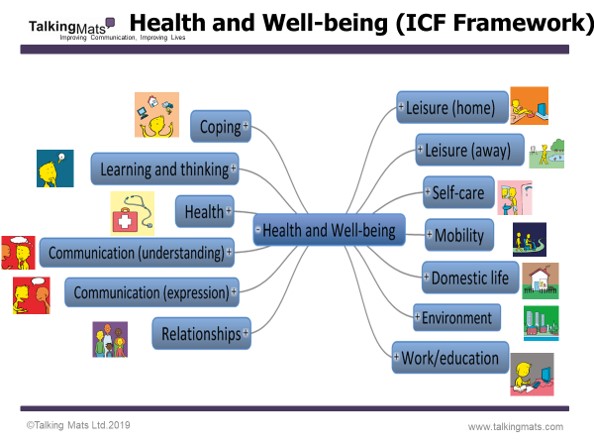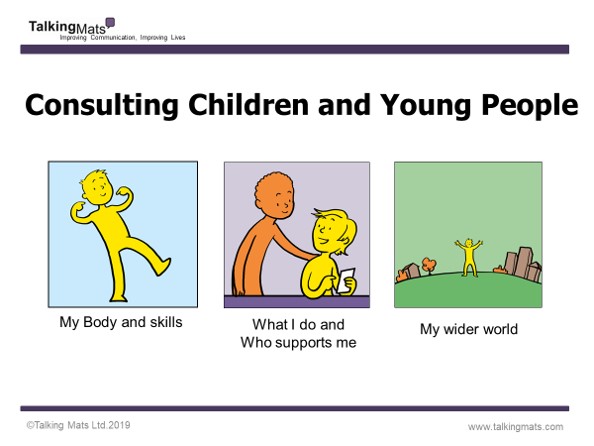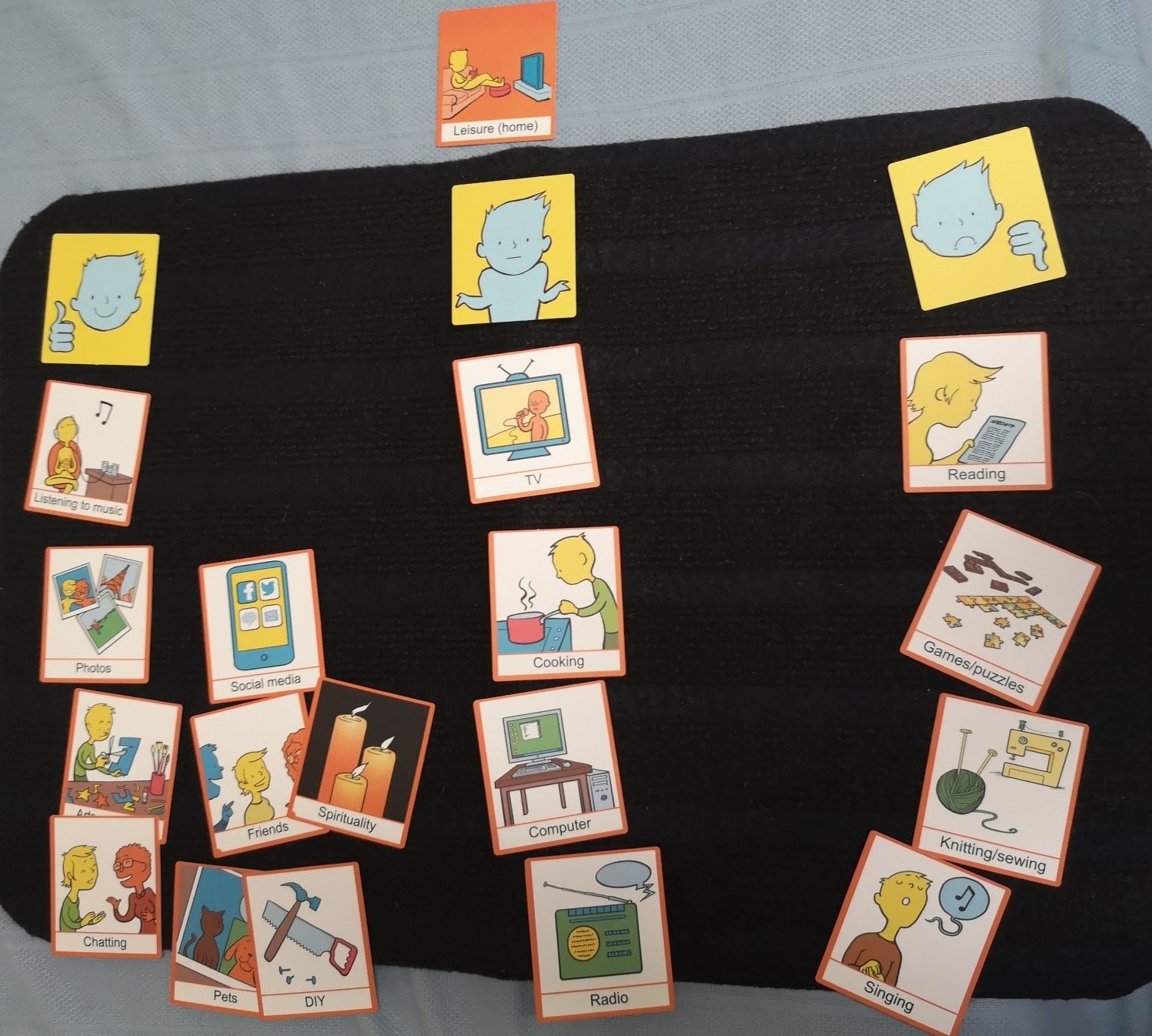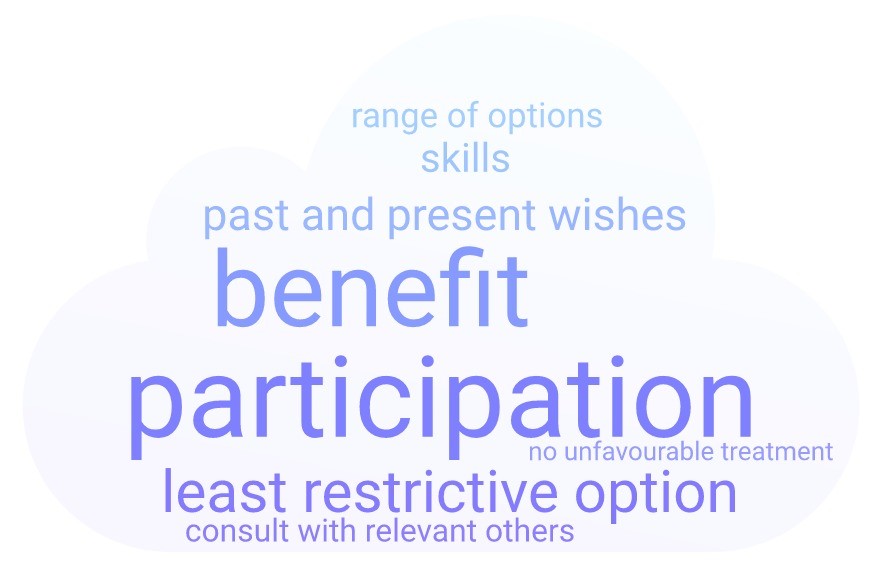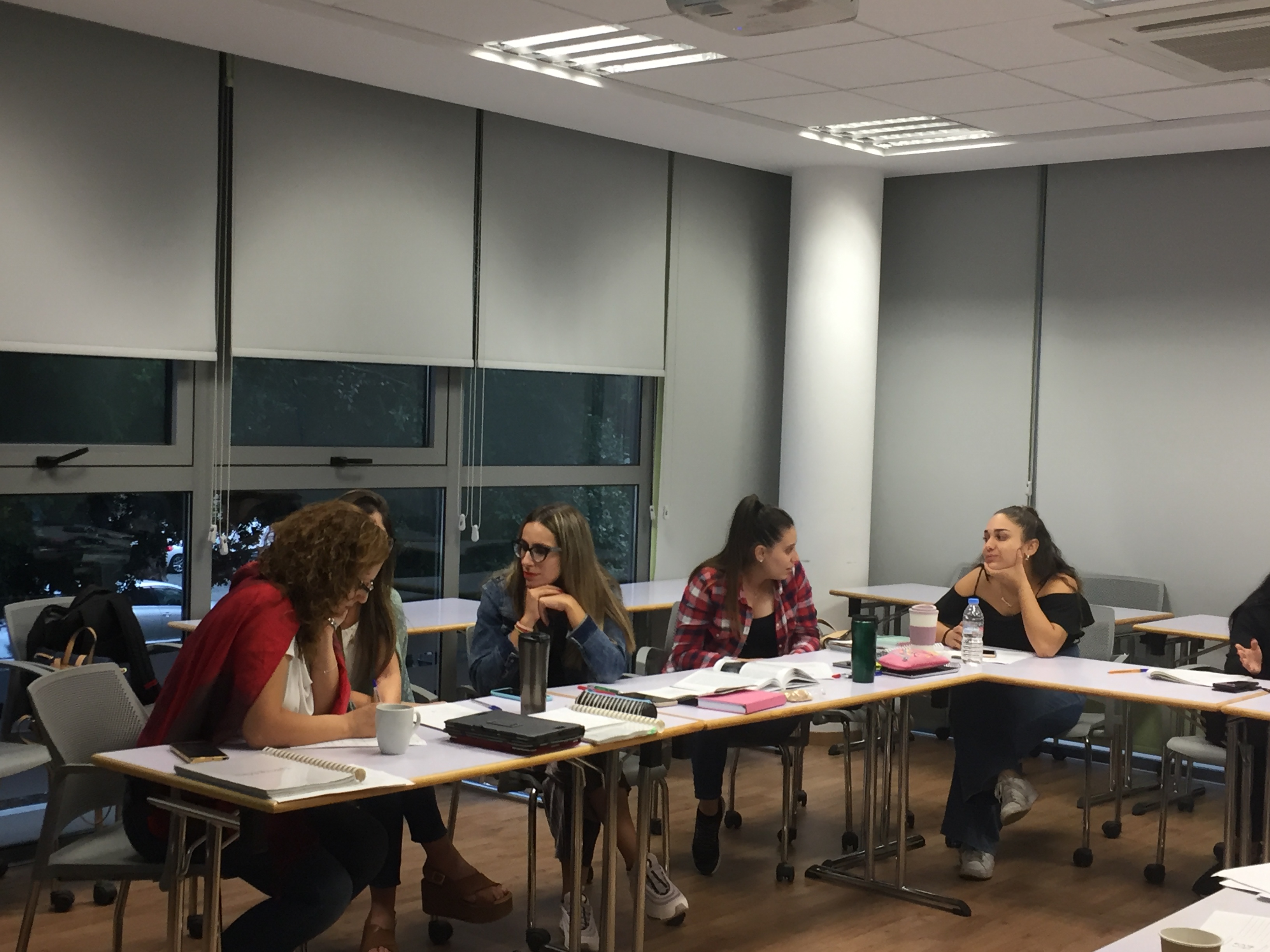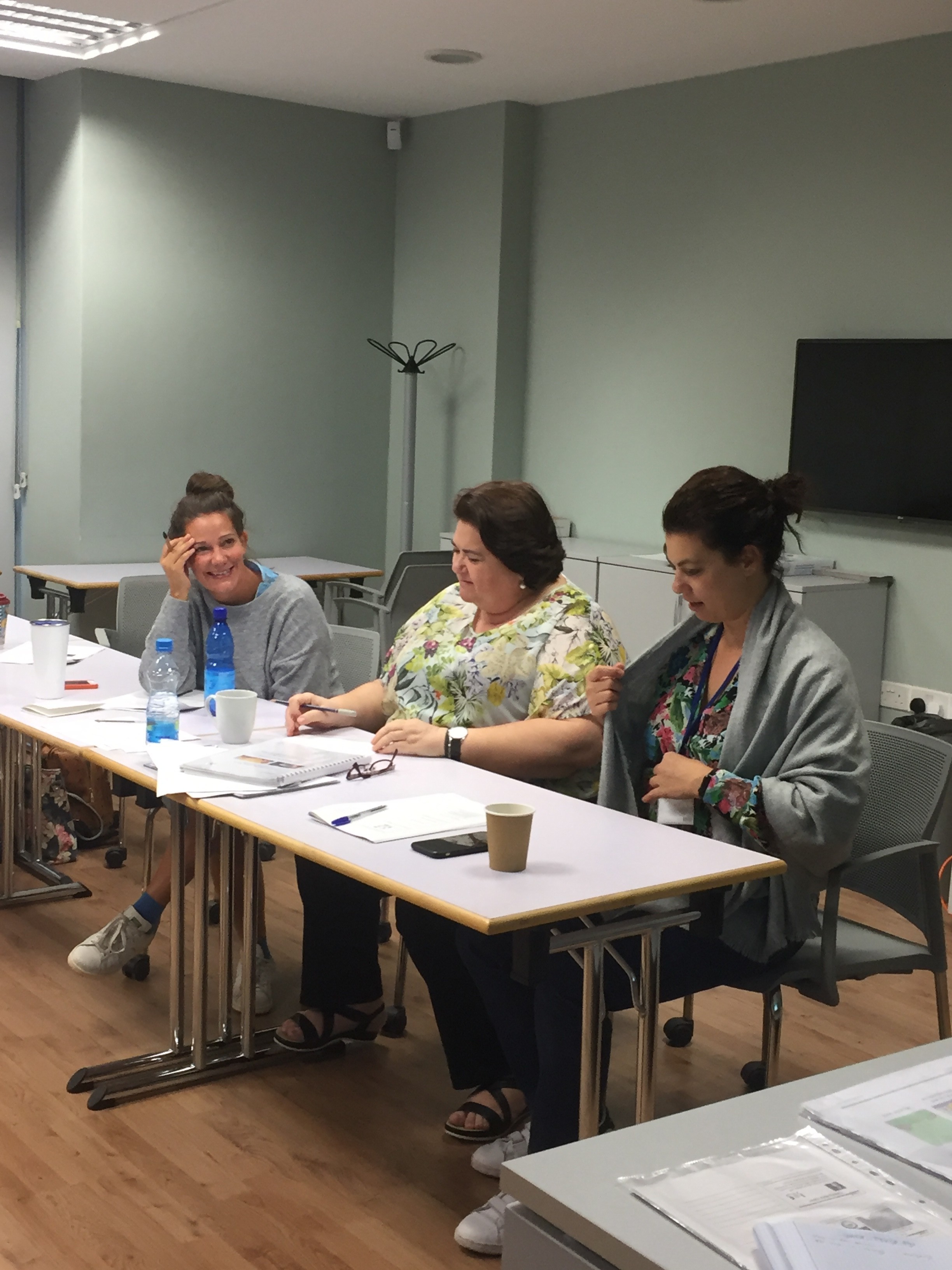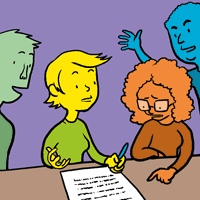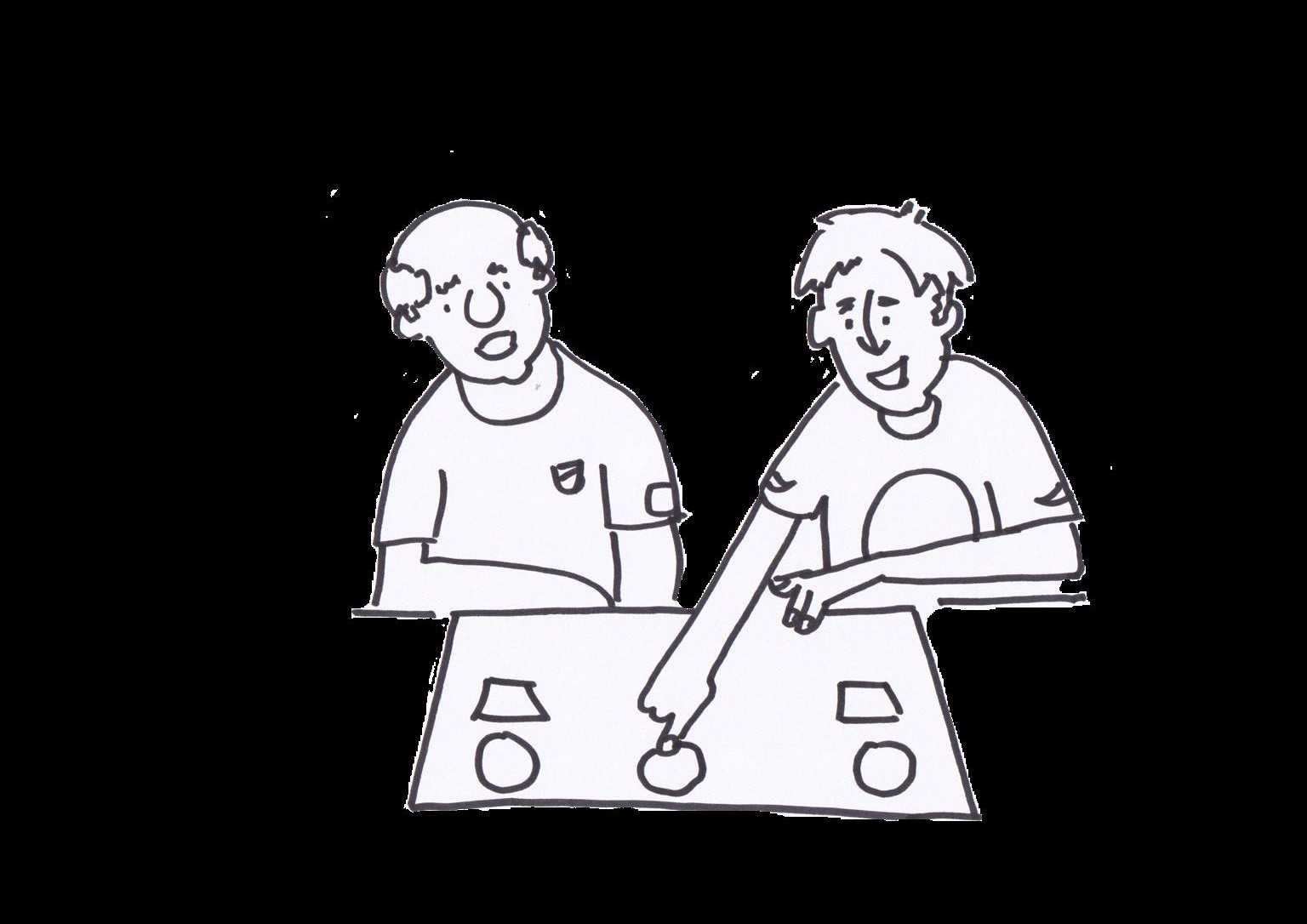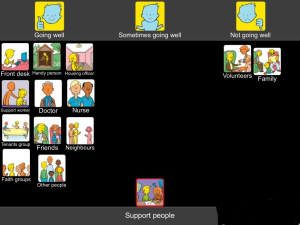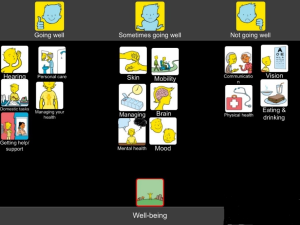In the first of two blogs, we talk about how using Talking Mats Resources can help people have better conversations.
Talking Mats provides a visual framework to help people express their views and feelings, using a selection of communication symbols that cover a variety of topics. Talking Mats resources are used by many professionals across a wide range of health, social care, residential, and education settings. Most of our resources are available in both low-tech, and digital, formats. In this first blog we focus on the resource bundles which are available to purchase with our Foundation Training course.
Our resources are available to buy through our website (https://www.talkingmats.com/shop/) however we do strongly recommend completion of one of our Foundation courses (https://www.talkingmats.com/training/foundation-training/) to get the most benefit from Talking Mats – and to use it to its full potential. If you add a Health and Wellbeing, Consulting Children & Young People, or Social Care resource pack bundle to your training you only end up paying £65 for the training day itself which is a great deal!
Resource Bundles available to purchase with Training
Health and Wellbeing Bundle:
These packs are based on the ‘activities and participation’ domains from the WHO ICF framework and includes 9 topics which are relevant to people, regardless of their health, disability or where they live around the world. We have translated these into more ‘user-friendly’ language and have generated symbols to represent each topic.
In addition to the 9 topics from the Activity and Participation domains, we have also included Environment and Health, which are important topics within the ICF framework and in people’s lives.
Consulting Children and Young People Bundle:
These packs are based on ‘Getting It Right For Every Child’ (GIRFEC), a Scottish framework for everyone to use when working with children and young people. There are three broad topics which are relevant to any child or young person’s life. This resource can also be used with SEND reforms in England. There are different packs for each developmental stage: Early years (ages 3 to 7); Primary (ages 7 to 12) and secondary (age 13 upwards).
Best Value Bundle: This option includes the Health and Wellbeing and Consulting Children and Young People bundles above, as well as our Social Care resource packs, providing a complete set of resources to support communication on a comprehensive range of topics for children and adults.
If you’d like to book a place on one of our Foundation Courses and would like to know more about our bundle options, get in touch with us at info@talkingmats.com
Find out more about our Foundation Training course here: https://www.talkingmats.com/training/foundation-training/
Many thanks to Georgia Bowker-Brady, Advanced Specialist SLT (Berkshire Healthcare Foundation Trust) for this latest guest blog.
I attended the Talking Mats training in June and I work in both dementia care and acute mental health in-patient services.
I had initially imagined that I would primarily be using the Talking Mats to support the dementia patients.
However I’ve been surprised to find that I have been increasingly using Talking Mats with functional patients and it has been a really positive tool when discussing with patients about their self-care, the care they are receiving in the hospital and opinions on discharge.
Due to their mental state, many of the patients may find it hard to organise and express their thoughts, and if patients are hypomanic it can be difficult for professionals to guide the topic to get meaningful information, but Talking Mats has really helped with this! It has also been pertinent in establishing patients’ insight levels and gaining better understanding of their impression of the current situation.
Here is a photo of one my mats from the psychiatric adult acute wards. This was for a patient who is severely low in mood and has relatively recently gone through a traumatic incident. The ward staff and OTs have had difficulty gathering any information about what she ordinarily enjoys doing in order find some activities to try and engage her with.
The staff stated that the patient would simply report she doesn’t enjoy anything and questions about what she used to enjoy received no answer. I went and did a joint session with the OT where I asked about what she enjoyed doing before this incident and we did the mat (see picture below) in a matter of minutes.
This can now provide a starting point for considering areas for trying to encourage some behavioural activation.
We then extended it by using an emotions wheel to ask how she felt about certain activities available in the hospital. We were able to establish that she felt fearful about trying new things and sad about carrying out certain activities she used to do prior to the incident.
It is wonderful to hear such a great example of Talking Mats in action – if you have any stories you would like to share, please get in touch with us at info@talkingmats.com
Many thanks to Claire Wiseman & Ann Lafferty from The Advocacy Project (Scotland) for this guest blog, including a great example of how Talking Mats helped a young woman with learning disabilities and psychosis share her views about being in hospital, receiving medical treatment and her preferences in respect of future post discharge welfare decisions:
For some time, The Advocacy Project have been thinking about how we could use the Talking Mats Framework to support people going through legislative processes such as the Mental Health (Care and Treatment) (Scotland) Act 2000, Adults with Incapacity (Scotland) Act 2000 and the Adult Support and Protection (Scotland) Act 2007.
Recently the Mental Welfare Commission published a best practice guidance on Supported Decision Making – https://www.mwcscot.org.uk/good-practice/guidance-advice, which we referred to as part of our presentation for the recent Talking Mats is 21 celebrations (click here to see the presentation Talking Mats and Supported Decision Making PP 2 (1)). The feedback from this session was that ‘yes’ there is a need for symbols to support legislation. As accredited trainers, we’ve also been asked when we’re delivering training to lawyers, Mental Health Officers, Social Workers, support workers and other advocacy organisations if there are specific symbols related to Supported Decision Making, particularly with regard to legislative issues.
Here is one of the Supported Decision Making and Talking Mats examples shared in our presentation:
One of our staff supported a young woman with a learning disability who was thought to be experiencing a psychotic episode. She had been detained in an in-patient learning disability unit under the Mental Health (Care and Treatment) (Scotland) Act 2003 on a Short Term Detention Certificate. The clinical team then made an application for a Compulsory Treatment Order, which was granted. Later, when discharge planning was in progress, an application for Welfare Guardianship was made under the Adults with Incapacity (Scotland) Act 2000.
Although the young woman was able to communicate verbally, the effects of the psychosis combined with her learning disability meant that her conversation was discursive and she was very easily distracted. Using a combination of Talking Mats and our additional symbols over a number of sessions, the advocacy worker managed to ascertain her views about being in hospital, receiving medical treatment and her preferences in respect of future post discharge welfare decisions.
The Talking Mats reports were submitted as evidence at two mental health tribunal hearings and the Welfare Guardianship hearing at the sheriff court. We received positive feedback from the Curator Ad Litem, Mental Health Officer and Sherriff regarding the reports as they had never had Talking Mats reports submitted before during these proceedings.
The use of Talking Mats had been instrumental in supporting the young woman to put forward her views and ensuring an outcome she was happy with.
Going forward, Talking Mats and The Advocacy Project will be exploring the possibility of a symbols set for Supported Decision Making and legislation. We are currently looking at funding possibilities.
A fantastic example of the power of Talking Mats – if you have any Talking Mats stories you would like to share, please get in touch! Just send me an email at laura@talkingmats.com
The Talking Mats Board is delighted to appoint Dr Jill Bradshaw from the Tizard Centre, University of Kent, to the position of honorary research associate. This is our first appointment of this kind. Talking Mats is an evidence-based framework and research is important to us – but that research needs to be much more diverse, and involve a much wider range of people.
Jill’s role will be to give the Talking Mats team:
- A sounding board for research ideas and proposals
- Advice and support on publishing articles
- Identify research gaps and advise on funding avenues
We are also very aware that a number of people are using Talking Mats as a research tool, and Jill will also help to develop a virtual research network to bring interested researchers together. We are still exploring ways in which this could work, but it could involve an email network, virtual seminars and/or twitter chats. If you are interested in being included, and have completed our Talking Mats Foundation Training course, Jill would love to hear from you. Please email her on J.Bradshaw@kent.ac.uk – or email info@talkingmats.com and we will forward your interest to her.
Jill is really excited about this new post. She says ‘We know that the voices of people who have communication challenges can be excluded from research. This is a great opportunity to work with others to think about how we can use Talking Mats creatively in research and to find ways of including views from a wider range of people’.
Lois Cameron
November 2019
Many thanks to our Talking Mats Founder, Dr Joan Murphy, for this latest blog talking about the training course she recently delivered at the Cyprus University of Technology.
Cyprus is a beautiful Mediterranean island with a population of approximately 1 million.
I was invited by Dr Eliada Pampoulou to run a 2-day course on Talking Mats for 12 Speech and Language Therapists, some of whom are masters students and some, lecturing staff at the Cyprus University of Technology. The Cyprus University of Technology founded the first Department of Rehabilitation Sciences in Cyprus and the Department offers the first public recognised university bachelor degree in Speech Language Therapy / Speech Language Pathology in the Greek language (https://www.cut.ac.cy/faculties/hsc/reh/).
Day 1 was a Talking Mats foundation training course and Day 2 focused on discussion around capacity, research and clinical applications. This model worked very well as the participants were able to think about and discuss how to apply the training immediately.
Some of the immediate plans of the participants were both clinical and research oriented and are outlined below:
- To administer the Greek Stroke and Aphasia Quality of Life Scale (SAQOL-39) with healthy people over 50 both with the text version and an adapted Talking Mats version quality and to examine which they prefer.
- To use Talking Mats both with people with people with aphasia and their carers in order to share their understanding about the communication skills and needs of people with aphasia.
- To use Talking Mats as a tool to identify the factors that are related to AAC system acceptance or abandonment by focusing directly to the views of people with complex communication needs
- To use Talking Mats as a goal setting tool for both paediatric and adult population
- To use Talking Mats to gets clients feedback about therapy services
- To use Talking Mats for student appraisals regarding their clinical training
Dr Eliada Pampoulou has created the first Talking Mats centre in Cyprus which aims to gather all people who received training every few months to share their experiences and support each other to embed Talking Mats in practice and research.
We hope that Eliada will come to Stirling next year to gain her Talking Mats licence to enable her to train others and extend the reach of Talking Mats even further.
We regularly run our Licensed Trainer 2-day courses at our base in Stirling – if you have attended Talking Mats Foundation Training and would like to train other people find out more here:
https://www.talkingmats.com/training/train-the-trainers-accredited-training/
Many thanks to Lynn Blair, SLT (NHS North Lanarkshire) for writing this guest blog describing a recent project in which she and her colleagues used Talking Mats to gather the thoughts of secondary-aged pupils with social, emotional and behavioural support needs:
Do you remember your school janitor? Was he/she a cheery soul who you enjoyed talking to? Perhaps there was another member of school staff who you trusted and felt you could chat with. Secondary school can be a challenging environment for any teenager, let alone those who have speech, language and communication needs (SLCN). Young people need adults in their lives who they can feel at ease talking with.
The purpose of our recent project (See Lanarkshire SLT SEBN Poster 2019 and Lanarkshire SEBN Project Summary) was twofold. Firstly we wanted to find out how many of the young people in our local secondary schools for pupils with social, emotional and behavioural needs (SEBN) had language and communication difficulties. We also wanted to hear about the impact of those support needs by gathering the thoughts of the pupils themselves and that’s the focus of this blog.
We have to admit we were a bit anxious before we met with the pupils. Would these young men and women even give us the time of day with our friendly faces, mats and pictures? In the actual event, for the most part the tool was met with curiosity and then full engagement. The young people quickly grasped the idea. Some did not speak at all as they placed the images and others used the opportunity to tell us a great deal about how they felt about talking to different people in their lives and in different settings.
The information that we gathered is now being used to plan evidence-based speech and language therapy services to the school and young people. The use of Talking Mats gave us interesting information like the fact young people felt auxiliary staff such as janitors and assistants are often easier to talk with than teachers and as a result, we are thinking about how we involve all school staff in future events.
We are only too aware that the young people we met have often felt excluded from other people and from certain places. Talking Mats gave them the opportunity to be heard and we’re excited to consider how we can use them in the next phase of our work to support their communication needs.
If you are feeling inspired and would like to find out more about accessing Talking Mats Training – check out this link here: https://www.talkingmats.com/training/
Many thanks to Susan Gowland, SLT at NHS Fife Forensic Learning Disability Service, for this guest blog summarising the fantastic presentation she delivered at our TM is 21 event in August 2019.
As a speech and language therapist within NHS Fife’s forensic learning disability service, I work across two low secure wards. In my presentation for the “Talking Mats is 21 event” I talked about the way in which Talking Mats is used within these wards and the positive impact this has had for staff and patients.
Regular Check In: “it’s the same questions, but it’s easier to talk with the pictures”
Some of the people I work with use Talking Mats as a regular check in tool. Conversations are often based around the Wellbeing, Relationships and Thoughts and Feelings cards of the Keeping Safe resource, with personalised adaptations agreed with the thinker. Some people who find it difficult to express how they are feeling and irritations can either build up to a serious incident or the person can get weighted down by unexpressed needs and concerns. For these people a regular check in can address the small things before they become big things. This can help the thinker feel listened and responded to, build experiences of communicating effectively, as well as trust and therapeutic relationships, all of which are assets which will support the person to move on.
Self Reporting: “It helps me understand how I’m feeling about things”
For some people, the check in can have a specific focus. In a hospital based forensic service, unexpected and unrecognised changes in mental health can lead to serious incidents. To address this we have used Talking Mats to talk about mental health. SLT have worked with individuals, psychiatry & nursing to identify personal symptoms of mental health changes. These symptoms become options in the Talking Mat & can be used to support person to self report at the times their mental health changes. Being able to do this enables people to discuss the support they need & reduce the risk of out of the blue incidents. The Talking Mat itself can be a support. As one thinker said, “Talking Mats relaxes you, it calms you down”.
As and when required:
The regular use of Talking Mats on the ward has led to other patients asking for Talking Mats sessions. As a licensed trainer I offer training to all professionals within our multi-disciplinary team and there is often at least one Talking Mats trained nurse on shift. This means ad hoc requests can be facilitated and some thinkers have started using Talking Mats in weekly meetings; as a tool to talk through emotional events and as a way of exploring the mixed emotions around discharge. In the words of one of the charge nurses:
“Talking Mats has enabled me to communicate with people in a way that is meaningful. To support someone to express and understand their thoughts and feelings regarding both joyous and distressing events is a privilege. The format may be simple, but the outcome is often comprehensive and insightful.”
(Picture drawn by Fiona Glanville, staff nurse, NHS Fife)
If you would like to find out more about accessing Talking Mats training, check out this link:
https://www.talkingmats.com/training/
If you are interested in our Keeping Safe resource mentioned here (available to those who have accessed our Foundation Training / Online Training Course) please see these links for more details:
https://www.talkingmats.com/keeping-safe-a-new-talking-mats-resource-available-to-purchase/
https://www.talkingmats.com/product/keeping-safe/
Many thanks to Dr Sally Boa, Head of Education, Research and Practice Development at Strathcarron Hospice in Stirlingshire, for this latest guest blog – linking to her great presentation at our TM is 21 event in August. Sally’s presentation – Talking Mats and Palliative care – focused on using Talking Mats in Palliative and End of Life Care, and included information about the Talking Mats ‘Thinking Ahead’ resource – here Sally shares her own experiences:
Talking about death and dying and making plans for the future is difficult to do. This is partly because no one likes to think about their own mortality and partly because as a society we don’t talk about it. I work in a hospice where people are encouraged to talk about the care and treatment they would want as their condition deteriorates. Even here, these conversations can be difficult, particularly if someone has communication or cognitive difficulties, if there is uncertainty about prognosis or if there are different opinions within the family. The ‘Thinking ahead’ Talking Mats resource is a great tool to use to enable these conversations to happen. In my presentation at the ‘Talking Mats is 21’ event, I provide some background about how the resource was developed. I have used it to support those with communication difficulties to have a voice and also with people who simply find this a difficult topic to think and talk about. Use of the Mats helps people to think through the issues one at a time and see for themselves how they feel about things in relation to one another. Most importantly, it helps open up the conversation about the future and helps people to prioritise and see for themselves what they need to do in relation to making plans for the future. Then they can get on with living and doing the things that are most important to them.
A most memorable example of using Talking Mats with someone towards the end of life is when I was asked to work with ‘Gill’ who had severe communication difficulties. I used the ‘Thinking ahead’ resource with her and found out that she had made many plans in relation to sorting out her affairs (e.g. power of attorney, funeral arrangements). She hesitated when I showed her the ‘making memories’ symbol and at the time I couldn’t work out why. To finish the session, I used the ‘indoor interests’ symbols with Gill and we had a great conversation about all the things she enjoyed doing. When I gave Gill the ‘arts and crafts’ symbol, she became really animated, and was able to tell me that she wanted to finish creating a memory book of photos that she had been making up for her family. Using the Mats, Gill managed to convey why she had hesitated with the ‘making memories’ symbol. Following on from this, we had a conversation with the hospice creative arts coordinator who was able to support Gill to complete, not only her memory book, but also other creative pieces. In her last few days of life, Gill was able to identify and work towards really important goals and left some amazing memories for her family.
To find out more about our Thinking Ahead resource, which is available to those who have accessed our Foundation Training – follow this link – https://www.talkingmats.com/product/thinking-ahead/
If you haven’t accessed our Foundation Training yet – find out more here https://www.talkingmats.com/training/foundation-training/
Recently, Associated Prof. Ida Marie Mundt from Denmark completed our Talking Mats licensed trainer course. She has been looking at the theories which underpin Talking Mats and is planning to publish her work. One of the areas she speaks about is Identity.
In this blog, our Talking Mats Associate Rhona Matthews explores the area of Identity:
How do I know who I am? This is learned from actions, behaviour and language firstly with parents and family, then with friends.
For people who have difficulty interacting, this becomes much more difficult. There is a danger that others construct their identity.
A participant on our online training wrote about her experience of doing a Talking Mat for the first time with a girl who uses augmentative communication. She has a severe difficulty expressing her ideas and thoughts.
The topic was leisure activities and the top scale was things I like to do/ don’t like to do. She did this quickly and with no great surprises. The listener felt she didn’t get particularly useful information.
So she repeated the topic but with a different top scale. Things I am good at/Things I’m not good at.
Not surprisingly there was overlap with the earlier attempt. i.e. the things she felt good at, she liked which included horse riding.
Again the listener felt there was more conversation to be had! The thinker coped easily with another change of top scale which was things I want to get better / don’t want to get better at.
This time when the option of horse riding was handed over, the thinker became very animated, nodding in agreement. Not only did she want to improve her horse riding skills but wanted to learn about looking after horses. Her family had no idea that actually she didn’t just like riding but saw herself as a rider. This was part of her identity.
As Assoc. Prof. Ida says, Talking Mats offers a possibility to talk about who you are, and get other peoples’ responses.
If you are interested in accessing Talking Mats training we offer a variety of options, including online – check these out here: https://www.talkingmats.com/training/
Talking Mats have been part of an exciting research project which looked at whether the Digital Talking Mat App could improve health and housing outcomes for social housing tenants.
Working together with tenants and staff from Loretto Housing and Care, Stirling University, Napier University and Age Scotland we have developed and piloted a new Talking Health and Housing set for the Talking Mats App!
Project Aims
The aim of the project was to:
- Develop an App that would support social housing tenants with communication difficulties to say what they thought about their Housing and Health.
- To improve communication between social housing tenants and health professionals.
Researchers were also keen to see whether the App would help to demonstrate the link between tenants’ housing and health solutions.
What we did
The Talking mats team facilitated two focus group sessions with all the partners to decide what topics were needed.
Once the mats had been completed the researchers from Stirling University and Napier University conducted interviews and focus groups with staff from Loretto and related Health professionals and then analysed the data from the mats.
The Talking Health and Housing set
The set has three topics: Home, Wellbeing, Support people
The Top scale for this set is Going well…Going well sometimes…Not going well
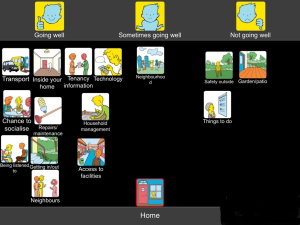
- A broken stair door
- Uneven pavement outside the house,
- Poor eyesight
- Poor mobility
This was having a negative impact on tenants’ wellbeing and by doing the mats, actions were identified to address all these concerns and anxieties were reduced.
It was a great partnership and we hope to work together again to further explore how the App can support the Service Integration agenda by facilitating communication between Health, Social and Care and Housing with the tenant at the centre.
Read the summary report 201908 Talking Health and Housing Summary Report
If you are interested in finding out more about the Talking Health and Housing App please email info@talkingmats.com
The Symbols are designed and © to Adam Murphy 2015 and assigned to Talking Mats Ltd. in perpetuity. They may not be reproduced without permission
 Online training login
Online training login 


